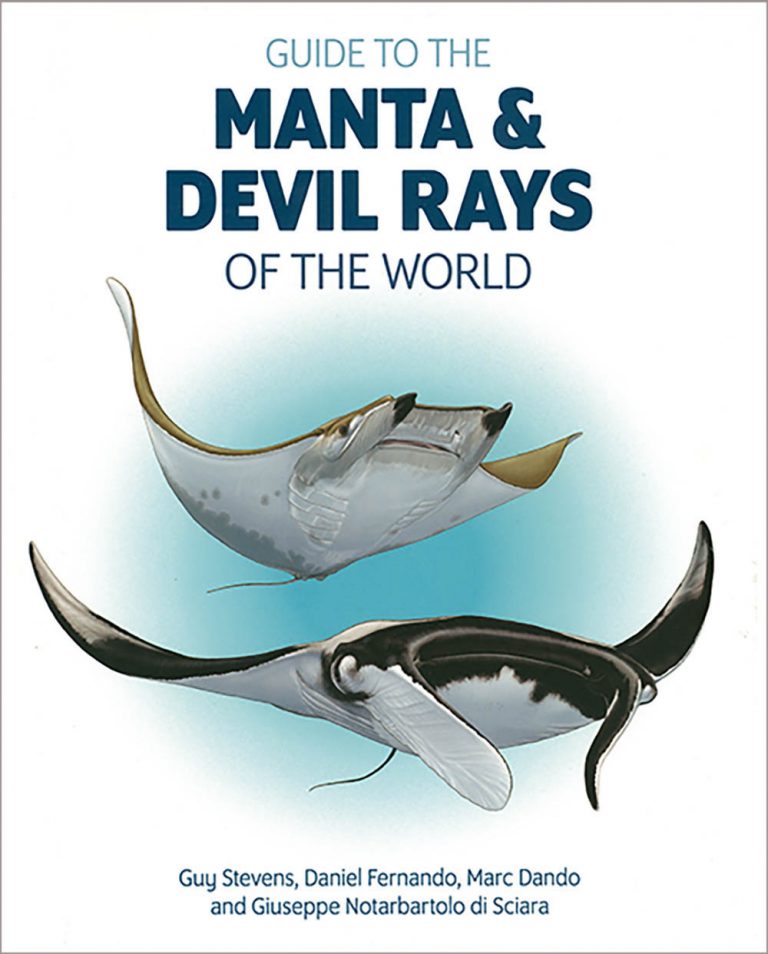Book Review
Celebration of Mobulids
Guide to the Manta and Devil Rays of the World, by Guy Stevens, Daniel Fernando, Marc Dando & Giuseppe Notarbartolo di Sciara

Appeared in DIVER July 2018
WHO DOESN’T LOVE DIVING with manta rays? I’ve yet to meet a diver who would actively avoid them. So this new book should find a ready market, the only question being how much you want or feel you need to know about mobulids – that is, the two (possibly three) species of manta, and eight of devil rays.
If you can’t get enough of them you’ll love this book, and there is a lot to know when you dig into the subject. Mobulids are slightly negatively buoyant and need to keep moving, which they do at up to 20mph. They have few predators, but when they do sustain a bite from a big shark or orca they have “an amazing ability to survive serious injuries”. They appear to be highly intelligent, with some behavioural studies suggesting that they might even be self-aware.
I was interested to discover that they have also developed eight distinct feeding styles – straight, surface, chain, piggyback, somersault, cyclone, sideways and bottom – and that the authors reckon they have identified a ninth, “lunge-feeding”.
Also that mighty pressure-waves caused when mantas breach could be calculated to bring others to join in a plankton feast – far from discouraging the competition, these rays often find that working co-operatively brings richer rewards.
The section on suckerfish is revealing too – one, the white house remora, makes its home in the manta’s mouth and uses a spike to prevent it closing too far, which must be uncomfortable to say the least.
Others dig themselves into body passages you’d think any self-respecting suckerfish would avoid.
The pages of the book are lit up with excellent photography from a wide variety of sources and the always-wonderful line and half-tone illustrations of Marc Dando.
For the average diver I would imagine that everything you need to know is here, and it’s an easy book to read and a good one to keep for reference. For the marine biologist with an interest in these pelagics, it should prove an invaluable information source.
The central section explaining and illustrating the differences between the 10 mobulids is especially useful if you want to get definitive ID on a photo you took while diving.
The writing style might be easy, but when in the last part of the book we get on to the subject of ray conservation, or the lack of it, the temperature rises as the passions of the authors sear through.
Of course, in a way this is wasted on the sort of person who has invested in a book about manta rays, but the writers’ frustration is clear.
Mobulid populations are being wiped out, largely because body-part marketers have persuaded weak-minded consumers in Asia that bits of manta gill-plate (never “gill-raker” – the book is very clear on that) can filter out germs the same way they once filtered plankton in the wild.
Selling those gullible consumers bits of the marketers would be as medically effective but far more satisfying for divers. Mobulids are naturally long-lived animals and have only one offspring at a time, so human predation is devastating.
The Save Our Seas Foundation funded the production of this book, and a satisfying production it is too. Royalties from each copy will be directed to the Manta Trust, the charity co-founded and run by co-author Guy Stevens.
Wild Nature Press
ISBN: 9780995567399
Softback, 144pp, 22x17cm, £14.99
Review by Steve Weinman

